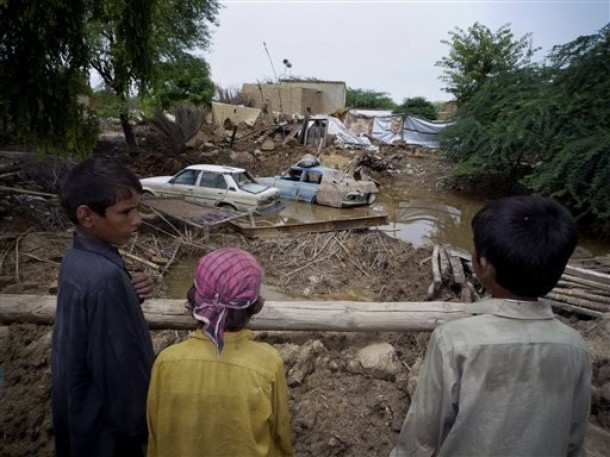
As the rains continue and floodwaters roar into Sindh and Punjab, the future of Pakistan as both a state and nation is in grave doubt.
To understand the magnitude of this catastrophe, imagine if in the United States much of the landmass from Boston to New Orleans east of the Mississippi was under 20 feet of water, roughly 60 million-100 million Americans became homeless and bridges and critical infrastructure were destroyed.
With Hurricane Katrina as an example, how well would the U.S. government be able to deal with such a disaster? The answer is that it probably couldn’t.
Then, how well is it likely that the Pakistani government and a nation that is decades behind the United States in standard of living, handle such an existential disaster?
Projections of 30 million-50 million displaced people from a population of 170 million-180 million Pakistanis — or roughly one-in-four — illustrate the potential cataclysmic magnitude. Cotton crops on which the economy depends for exports have been virtually eliminated for at least a year and probably many more. The wheat crop on which the nation depends for food has been wiped out. And reports of disease are beginning to mount.
So far, the Obama administration has viewed this as a humanitarian crisis when indeed it is a looming geostrategic catastrophe if not contained first. How much of a calamity it will prove is still not certain. However, in a worst case scenario, this catastrophe could approach the guns of August in 1914 that precipitated World War I in possible consequence.
The reasons for this seemingly over-the-top scenario are almost self-evident. Neither the Pakistani government nor its army may have the capacity to respond to this disaster and unprecedented human misery to keep the country together. The widespread collapse of bridges, roads and power generation has isolated huge swatches of Pakistan making transportation impossible except by air meaning helicopters of which there only a handful.
This is what happened in East Pakistan in 1970. The government couldn’t respond to floods causing East Pakistanis to riot leading to the 1971 war with India that created Bangladesh. The current government, too, could be overwhelmed.
Al-Qaida, Taliban and other extremist groups are no doubt purchasing one-way air tickets back to Pakistan. The disaster offers a great opportunity for jihadi extremists and other insurgents to set up shop relatively safe from government intervention and begin recruiting new disciples. Terrorists need not flock to Yemen or Somalia. Pakistan will offer a safe and fertile refuge for their operations. The image of Lenin boarding the train back to Russia in 1917 comes to mind.
As anarchy intensifies, what will India do? Insurgents have every incentive to provoke India through another Mumbai-like attack to finish off an already reeling government in Islamabad thus allowing insurgents the chance to dominate and convert large parts of Pakistan. What happened in Swat and Waziristan as well as the old northwest frontier now renamed Khyber-Pakhtunkhwa will be recreated on possibly a Frankensteinian scale.
An unruleable Pakistan means that the NATO and Western coalition in Afghanistan cannot succeed. Supply routes from Karachi northward to Afghanistan will be seriously affected by the floods. More importantly, insurgents will find refuge more easily in Pakistan’s northwest territories as the Pakistani army turns inward to help relieve the catastrophic damage caused by the floods.
Meanwhile, the Obama White House fiddles while Pakistan drowns. The U.S. secretary of state tells Pakistan’s president that the world is suffering from “Haiti Fatigue,” meaning that aid and support are likely to be limited. When asked if its nuclear weapons security facilities are waterproof, a senior Pakistani general responded, “they are ‘everything’ proof.” But in these calamitous times, are they?
The prospect of a fractured Pakistan with instability pouring out of the region across the rest of the globe may sound a bridge too far. In part, that is because much of the world including the Washington political elite have so far not grasped the extent of the damage wrought by the floods and the extreme consequences that could lie ahead. And there are frightening scenarios namely a pandemic spread of disease not limited to South Asia as well an Indo-Pak War precipitated by an act of terror.
Unless or until the disaster in Pakistan is recognized as a geostrategic matter and not simply another humanitarian tragedy, the chances of Pakistan muddling through are slim. And even if the broader political implications are realized, can the United States and world deliver? The United States has poured hundreds of billions of dollars in Iraq and Afghanistan and gotten very little in return. Even a fraction of those resources sent to Pakistan, assuming they can be administered, would be more than worth it.
Harlan Ullman is Senior Advisor at the Atlantic Council, Chairman of the Killowen Group that advises leaders of government and business, and a frequent advisor to NATO. This article was syndicated by UPI. Photo credit: AP.
This article is part of the series Pakistan Floods: Hope from Tragedy. To find a series description and links to related posts, please click here.
Image: Pakistan%20floods%206.jpg
